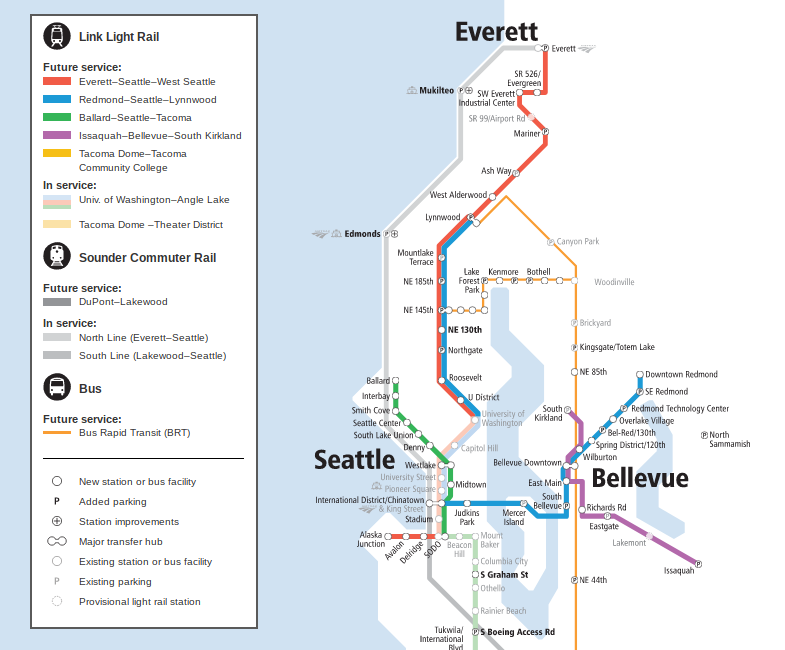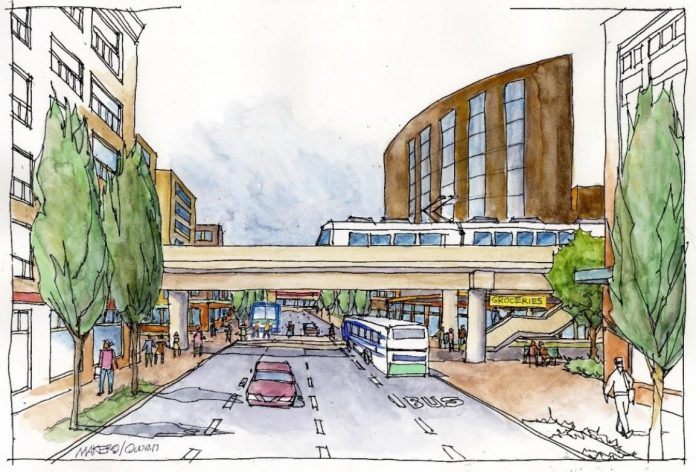
Sound Transit is rethinking its costly crook to Paine Field.
Sound Transit revealed new alternatives for Everett Link light rail this week that could take a more direct route via SR 99 or I-5 rather than the circuitous Paine Field diversion. As the most direct route, the I-5 alignment could shave about nine minutes off the trip between Lynnwood and downtown Everett, The Urbanist has estimated.
Snohomish County officials have been anxiously awaiting light rail’s arrival to their communities, but they also advanced a costly alignment doglegging over to Paine Field that appears likely to force a cost crunch, delayed opening, and a significantly slower trip for riders. Sound Transit is reconsidering that decision with the reintroduction of more direct options to reach downtown Everett that should be more cost-effective and able to meet or improve upon the extension’s current targeted opening date of 2037.
During a presentation to the Everett Link Extension Community Advisory Group, Sound Transit officials stopped short of saying the I-5 route could open sooner than 2037, but they did imply the Paine Field alternative would struggle to open by that target due to its greater cost.
“To go back to why we’re looking at this alignment in the first place is people were trying to get to Everett quicker for lower cost, so I think it could be done quicker,” said Eric Widstrand, who is director of corridor development for Everett Link. “But I think the goal would be to get to Everett by the desired construction date of 2037.”
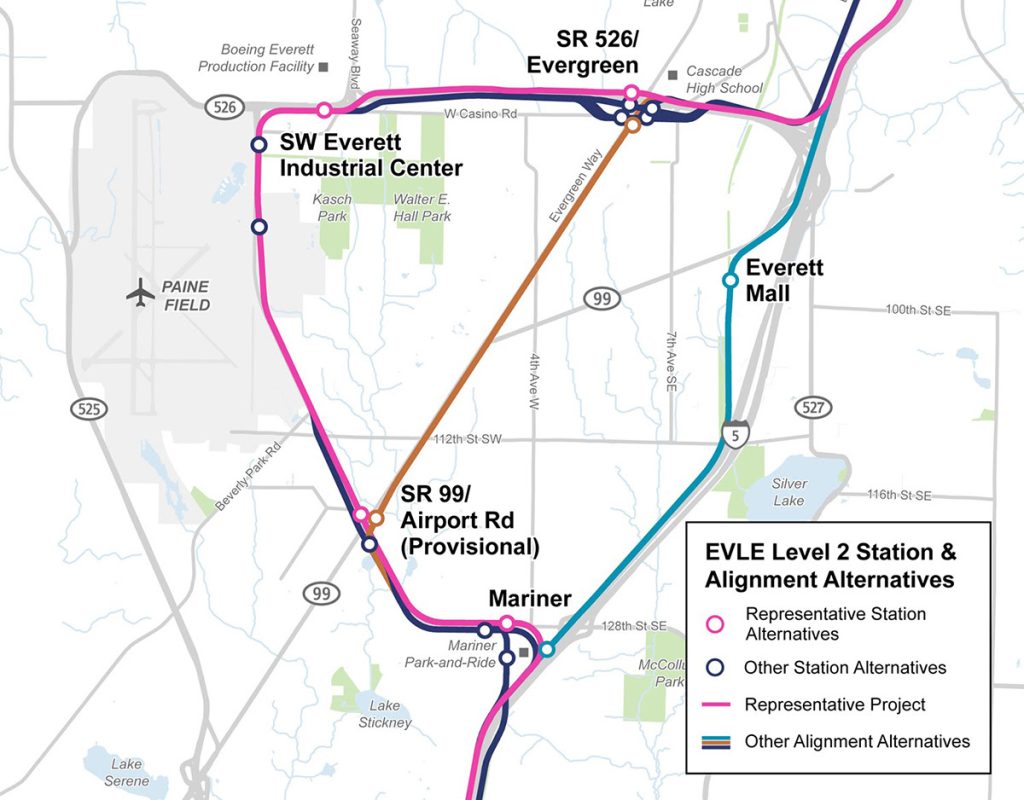
Last year, The Urbanist’s Stephen Fesler laid out the arguments against the Paine Field light rail alternative and proposed a direct I-5 alignment paired with bus rapid transit to serve the airport and the Southwest Everett Industrial Center. It appears Sound Transit may have arrived at a similar place, though rising cost estimates might be forcing the agency’s hand.
Fesler pointed to increased cost estimates for Everett Link that could reach about $500 million per mile when including the Operations and Maintenance Facility North project. Based on that per-mile cost figure, Fesler estimated the I-5 alignment would save about $2 billion since it’s four miles shorter and requires less costly property acquisitions. Sound Transit declined to offer a cost savings estimate at this juncture, but said they will have one by the end of the year.
Creating a faster light rail line
Regardless of cost concerns, more direct routes would offer faster times for riders, cutting down trips time to Lynnwood and beyond.
“With the current plan for light rail to both serve as the spine and to connect to Boeing, the Everett-to-Lynnwood project is projected to take 33 minutes and the Seattle trip is projected to take 60 minutes. That’s only slightly better than Sound Transit’s existing Route 512 bus that is scheduled to take 64 minutes to run from Downtown Everett to Downtown Seattle,” Fesler wrote. “With a fourth of the miles eliminated from the route, a trip from Everett to Lynnwood might take just 24 minutes, and a trip to Downtown Seattle 51 minutes.”
The time savings for the SR 99/Evergreen Way routing may not be quite as dramatic, but it should still shave off about four or five minutes while also serving the densest population centers along SR 99. The station at SR 99 and Airport Road was “provisional” under the Paine Field alignment, which is agency speak for not yet funded. It would be included in the Evergreen alignment, which is great for connecting to bus rapid transit, since Community Transit’s Swift Blue and Swift Green lines cross at that intersection.
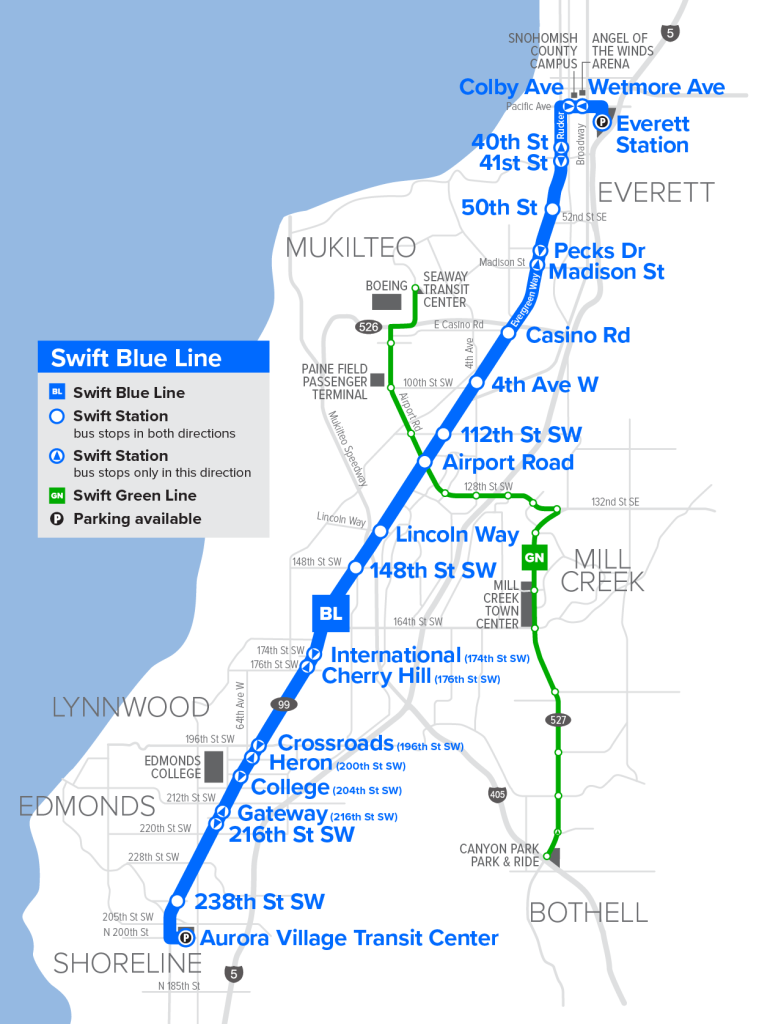
The Green Line has stops at Paine Field and at the Boeing plant. This could give the SR 99 alternative the edge for both transit connectivity and transit-oriented development (TOD) potential.
How to serve Southwest Everett Industrial Center
The arguments for the Paine Field dogleg centered around serving the fledging airport at Paine Field, the Boeing factory, and the greater industrial center around it. Sound Transit’s modeling, however, predicted fairly anemic ridership — in part because those facilities tend to be spread out and car-oriented, as is the workforce. “The problem is that so many [Boeing] employees live in places poorly served by transit, like Bothell, Lake Stevens, Marysville, Stanwood, and Skagit County, and that their alternative of driving the freeways and parking for free provides a far superior time savings,” Fesler wrote.
Plus, Boeing is increasingly pulling jobs out of Washington State despite the generous tax breaks repeatedly handed to the corporation by the state legislature over the years. Given the company’s recent struggles and moves, there’s no guarantee the Everett Boeing facility will still be operating by the time Everett Link opens. And even if Boeing stays or the industrial center rebounds, a circulator bus ferrying riders from the station closer to their destination might work just as well for commuters as a light rail stop at the edge of a sprawling campus.
A bus rapid transit spur to Paine Field to pair with the more direct alignment appears to be outside of the scope of study, and Sound Transit did not mention the idea in their presentation. The advisory group did ask about a light rail spur to Paine Field, and Widstrand confirmed the agency had deemed that out of scope for Sound Transit 3 (ST3) work, but could potentially explore it in a future ST4 expansion.
While details on the new alternatives are light for now, Sound Transit said the next level of analysis will compare factors such ridership forecasts, costs, transit-oriented development potential, service to growth centers, service to job centers, equity and construction challenges/impacts. That picture should allow a fuller comparison between the three alternatives.
In his comments, advisory group member Nick Coelho said he looks forward to the results of the analysis and thanked Sound Transit for adding the alternatives back in to better guide the final decision and inform the recommendations the advisory group will make.
“I think I speak for every single resident of Snohomish County when I say thank you for looking at these alternatives, even if they’re not as beneficial as perhaps going to Paine Field,” Coelho said. “Having these options that go straight to Everett and at least show that you’re willing to put in the work to study these alternatives is really important for this organization, and it’s important to us to be able say that we’re doing our jobs of representing the community.”
Everett Mall overhaul?
The Everett Mall station in the I-5 alternative brought up some interesting discussion among advisory group members. Some worried it would attract little ridership due to a lack of attractions and mall tenants.
“The alignment on I-5, it’s just going to go the mall, and I don’t know if you have been to the Everett Mall lately, but there’s not much going on there,” Luis Burbano said. “I think the other two lines are way superior.”
Allan Giffen, who used to be director of planning and community development for the City of Everett, argued the dead mall could have a transit-oriented development renaissance. Cities like Tacoma to Kirkland have sought to advance TOD-focused mall overhauls.
“A station in that location represents a really great opportunity for redevelopment with transit-oriented development, a large area that’s underperforming as a mall, opportunities to incorporate housing as well as commercial services,” Giffen said.
Transit-oriented development overview
Even if the Everett Mall TOD makeover were to be carried out, one drawback of the I-5 alignment is that it only has one station between downtown Everett and Mariner Station. Stopping at fewer stations is another factor that makes the route faster, but it also means its TOD potential is limited to just that one station, which could hamstring ridership as well.
To address this, Sound Transit could potentially add another station to the line, such as in the vicinity of 112th Street SW, which has the makings of a good bus artery. But stops along I-5 will always have disrupted station areas and stilted walksheds due to the presence of the freeway, which cuts into their TOD potential.
In contrast, the SR 99 alignment would have two stations with major TOD potential between Mariner and downtown. Evergreen Way is already identified as an area for urban redevelopment by the City of Everett, with a revitalization-focused Subarea Plan completed in 2012. The Evergreen Way and SR 99 corridor was a focal point of dense urban zoning in Everett’s 2020 zoning update. Stations here have great TOD potential, particularly if the City of Everett and the Washington State Department of Transportation step up and calm the highways to make them more walkable and urban.
The Paine Field alignment has four stations plus the fifth provisional station at SR 99, giving it a greater catchment area. However, the three station in the Southwest Everett Industrial Center are likely to keep their industrial focus and zoning rather than see housing development. Thus, it’s not clear the TOD potential is greater than the SR 99 alternative, particularly if the provisional station does not materialize.
OMF North implications
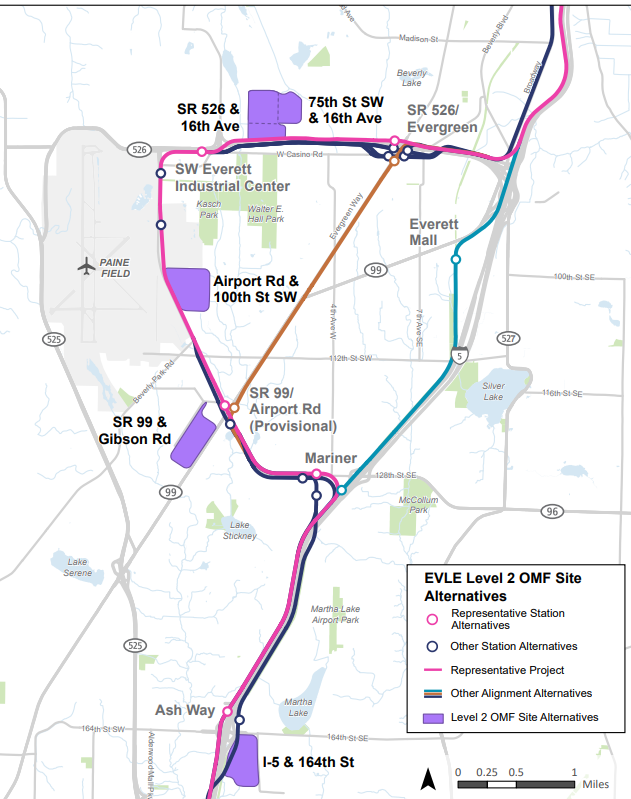
Each alternative would come with a different location for the north operations and maintenance facility (dubbed OMF North) where light rail vehicles would be stored and serviced for this segment. Sound Transit said it needs about 60 to 70 acres for this purpose. At this stage, Sound Transit believes the I-5 alignment means OMF North would go opposite Ash Way at 164th Street SW. The SR 99 alternative puts the station just southwest of the Airport Road station on SR 99 — perhaps a mixed-use housing development could be built above the facility given the close proximity to the station. The existing Paine Field dogleg comes with two locations for OMF North in the Southwest Everett Industrial Center.
Everett Link Extension planning is advancing on a bit slower timeline than West Seattle and Ballard Link extensions, which means final alignments are still farther out. Sound Transit anticipates switching to design work in 2026 and beginning construction in 2030. There is still time for Sound Transit and its regional partners to settle on a Everett Link alignment that best meet the needs of the community and sets the light rail spine on course for long-term success.
Doug Trumm is publisher of The Urbanist. An Urbanist writer since 2015, he dreams of pedestrian streets, bus lanes, and a mass-timber building spree to end our housing crisis. He graduated from the Evans School of Public Policy and Governance at the University of Washington in 2019. He lives in Seattle's Fremont neighborhood and loves to explore the city by foot and by bike.

